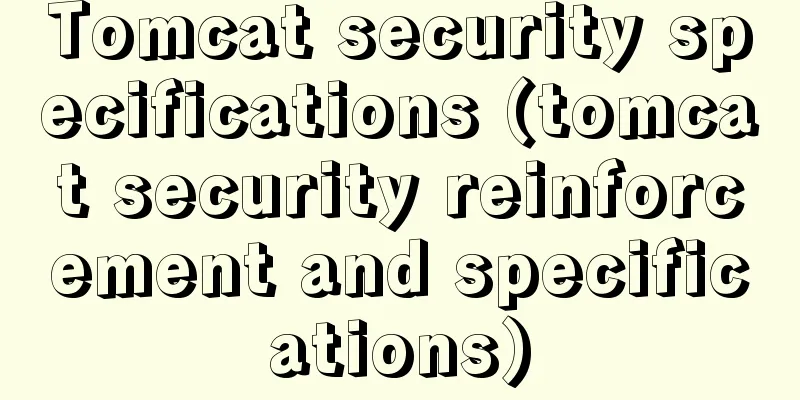Tomcat security specifications (tomcat security reinforcement and specifications)

|
tomcat is an open source web server. The web based on Tomcat has high running efficiency and can run smoothly on general hardware platforms. Therefore, it is quite popular among webmasters. However, under the default configuration, it has certain security risks and can be attacked maliciously. Here are some security enhancements: Version security Upgrade to the latest stable version. For stability reasons, cross-version upgrades are not recommended. Service demotion Do not use the root user to start Tomcat. Use a normal user to start Tomcat. The user name in the cluster is unified with UID Port protection 1 Change the tomcat management port 8005. This port has the authority to shut down the tomcat service, but the port must be configured between 8000 and 8999, and change the shutdown command. Disable the management terminal 1 Delete the default $CATALINA_HOME/conf/tomcat-users.xml file and restart Tomcat to automatically generate a new file Hide Tomcat version information The display of this information is controlled by a jar package, which is stored in the $CATALINA_HOME/lib directory and is named catalina.jar. Disable automatic war deployment By default, Tomcat enables hot deployment of war packages. In order to prevent the implantation of Trojans and other malicious programs, we need to turn off automatic deployment. Modify the instance:
Custom error pages Edit conf/web.xml and add the following content above the </web-app> tag: <error-page> <error-code>404</error-code> <location>/404.html</location> </error-page> <error-page> <error-code>500</error-code> <location>/500.html</location> </error-page> Shield directory files from being automatically listed Edit the conf/web.xml file
<servlet>
<servlet-name>default</servlet-name>
<servlet-class>org.apache.catalina.servlets.DefaultServlet</servlet-class>
<init-param>
<param-name>debug</param-name>
<param-value>0</param-value>
</init-param>
<init-param>
<param-name>listings</param-name>
<param-value>false</param-value>
</init-param>
<load-on-startup>1</load-on-startup>
</servlet>
<param-value>false</param-value>Here false means not to list, true means to allow listing Multiple virtual hosts It is strongly recommended not to use Tomcat's virtual hosts, and it is recommended to use one instance per site. That is, you can start multiple Tomcats instead of starting one Tomcat containing multiple virtual hosts. Script permission recovery Control the executable permissions of start.sh, catalina.sh, and shutdown.sh in the CATALINAHOME/bin directory Separate Tomcat and project users To prevent Tomcat from being implanted into the web shell program, you can modify the project file. Therefore, we need to separate Tomcat from the project owner, so that even if it is hacked, it will not be able to create and edit project files. Server head rewrite Add server configuration server="server_name" to the HTTP Connector configuration. The default is Apache-Copyote/1.1
Access log format specification <br /> Enable Referer and User-Agent records in the default access log of tomcat Standard Configuration:
Tomcat disables illegal HTTP methods Edit the configuration in the web.xml file <init-param> of org.apache.catalina.servlets.DefaultServlet <param-name>readonly</param-name> <param-value>true</param-value> </init-param> When param-value is true, delete and put operations are not allowed. The tomcat user has remote management permissions <br /> In tomcat-users.xml, modify the role value of the tomcat user to include manager, such as:
The automatic logout time of tomcat is no more than 30 seconds <br /> Edit server.xml and change the automatic logout time to 30 seconds, as follows: <Connector port="8080" maxHttpHeaderSize="8192" maxThreads="150" minSpareThreads="25" maxSpareThreads="75", enableLookups="false" redirectPort="8443" acceptCount="100" connectionTimeout="30000" disableUploadTimeout="true" /> Tomcat should set the minimum and maximum number of connections based on machine performance and business needs. Edit the server.xml file, The example is as follows: <Connector port="8080" minSpareThreads="25" .../> Edit the server.xml file, Tomcat configuration access log <br /> Modify server.xml and uncomment the following content: <Valve className="org.apache.catalina.valves.AccessLogValve" Directory=”logs” prefix=”localhost_access_log.” Suffix=”.txt” Pattern="common" resloveHosts="false"/> Configure Tomcat error page redirection Edit the web.xml file and modify it as follows: <error-page> <error-code>404</error-code> <location>/noFile.htm</location> </error-page> ………… <error-page> <exception-type>java.lang.NullPointerException</exception-type> <location>/error.jsp</location> </error-page> This is the end of this article. The editor of 123WORDPRESS.COM will share more knowledge with you later. You may also be interested in:
|
<<: An example of how to query data in MySQL and update it to another table based on conditions
>>: Implementation of vite+vue3.0+ts+element-plus to quickly build a project
Recommend
Docker deployment MySQL8 cluster (one master and two slaves) implementation steps
Table of contents 1. Install Docker on CentOS 7.9...
How to create a virtual environment using virtualenv under Windows (two ways)
Operating system: windowns10_x64 Python version: ...
Implementation of React star rating component
The requirement is to pass in the rating data for...
Solve the problem that the time zone cannot be set in Linux environment
When changing the time zone under Linux, it is al...
Detailed steps to upgrade mysql8.0.11 to mysql8.0.17 under win2008
Upgrade background: In order to solve the vulnera...
Detailed steps to install python3.7 on CentOS6.5
1. Download Python 3 wget https://www.python.org/...
MySQL 8.0.13 decompression version installation and configuration method graphic tutorial
1. Installation 1. Download MySQL Download addres...
How to get the height of MySQL innodb B+tree
Preface The reason why MySQL's innodb engine ...
Vue implements the countdown component for second kills
This article shares the specific code of Vue to i...
Detailed explanation of the practical use of HTML table layout
When is the table used? Nowadays, tables are gene...
SVG+CSS3 to achieve a dynamic wave effect
A vector wave <svg viewBox="0 0 560 20&qu...
MySQL calculates the number of days, months, and years between two dates
The MySQL built-in date function TIMESTAMPDIFF ca...
Detailed explanation of Vite's new experience
What is Vite? (It’s a new toy on the front end) V...
MySQL trigger trigger add, delete, modify and query operation example
This article uses examples to describe the add, d...
Add unlimited fonts to your website with Google Web Fonts
For a long time, website development was hampered...









